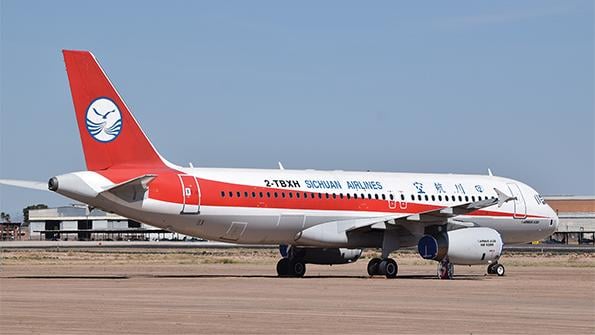MRO Prospects For Airbus A320 | エアバスA320のMRO需要の展望

いくつかの主要な国内線マーケットが復活しつつあることは、エアバスA320を含むナローボディ機のメンテナンスを行うMRO事業者にとってもいいニュースだ。
Aviation Week Intelligence Network(AWIN)によると、6月中旬時点で5,912機のA320ファミリーが定期運航に用いられている一方、2,900機近くは今も駐機または保管状態に置かれている。ほぼ全てのA320ファミリーが旅客便に用いられており、A320-200F貨物機はわずか3機が運航中、1機が駐機中だ。
A320-200ceoおよびA321-200ceoが運航中のフリートの60%近くを占めている。Neoシリーズについては受注残の大半を占めており、今後のデリバリーのほぼ80%を占める。
A320ファミリーのMRO需要は2021年の152億ドルから2025年には207億ドルに達する見込みで、Aviation Week Commercial Fleet and MRO Forecastのデータによれば、これは今後10年間の民間機MRO需要の24%を占める。A320/321ceoがこの需要のうち70%を占め、A320/321neoが20%を占める。
Lufthanza Technik(LHT)社の幹部によると、A320neoの稼働が増加していく中でメンテナンス需要も増加し、A320ceoと逆転しつつある。これは、一般的により大規模な整備が必要となる旧型機はすでに退役したか、運航再開に向けて保管されているからだ。また、パンデミックによりエアバス社が認めた6ヶ月間の整備猶予期間により、今後24ヶ月間で機材を均等に運航再開させられるため、MRO需要の急激な増加はある程度平準化されることになるだろう。
しかし、たとえ需要が平準化されたとしても、運航再開には課題が残る。 LHT社のCEO・Marcus Motschenbacher氏は「同時期に多くの需要に応えるためには、広いネットワークを持つ柔軟なMRO体制が必要だ」と断言する。また、耐空性管理を継続し、Part-21に対応するためのエンジニアリング機関へのアクセスも必要だ。「保管期間が4ヶ月未満だったとしても、徹底したチェックが必要だ」と同氏は述べた。
MRO事業者への厳しい財務的圧力を考慮し、航空会社はより長期的かつ魅力的な整備契約を望んでいる。Motschenbacher氏によると「マーケットではより大規模な入札が増えている」という。
それとは対照的に、リース会社が新たなリース先を見つけた際は、基本的な整備のみを実施している。「彼らは所有機材に充分な整備がなされ、なんなら改装されることを望んでいる」と同氏は説明する。一部のリース会社は、民間機の運航再開が増えることでMRO作業を実施するためのスロットが不足し、新たなリース先への引き渡しが遅れることを懸念している。
Aviation Technical Services社CEOのPaul Dolan氏は、今後12ヶ月間のA320ファミリーには非常に強いメンテナンス需要があると考えており、MRO業界はA320およびボーイング737両方の需要に対応するために苦労することになると予想している。
また、航空会社およびリース会社双方からの需要があるとも予想されており、「マーケットが急回復した際には、航空会社は輸送需要に応えるために奔走することになり、リース会社はリース先のフリートに機材を追加することでそれをサポートし、その需要のマーケティングを進めている」と彼は話す。
Dolan氏は、一般的にA320の軽整備には10〜12日、より大規模な整備には20〜35日必要と見積もっており、Motschenbacher氏も多様な整備期間が考えられるとしている。A320の新造機が24ヶ月目に迎える最初のC整備では、改装がなく、必要最小限の作業を行うだけであれば、5日間(工数1,500時間)で完了する。逆に、耐用年数の延長や構造部分の改修/修正を伴う重整備の場合は40日間(工数20,000時間)に達することもある。これらを平均して、彼はA320の基本的な整備には24日必要だと計算している。
さらに、通常のMRO作業とは別に、A320はアドバイザリー・サーキュラーやサービスブリテンを満たすための作業が必要になることもある。また、一部の機体では濡れる部分や翼面の腐食を修復する作業も必要になるとMotschenbacher氏は話す。
Air France Industries and KLM Engineering & Maintenance社でビジネスインテリジェンスを統括するAhmoss Messayeh氏は、一部の航空会社は大規模整備をいくつかの小さな作業に分割することで、夏場のキャパシティ・資金・機材繰りを確保していると話す。AFI KLM E&M社においても、リース会社からリース返却および保管時のメンテナンス依頼を受けているという。
MRO Prospectorで契約情報を検索し、受注機会を発見しましょう
MRO Prospectorは民間機MRO(メンテナンス・修理・オーバーホール)契約の特定、予想される個別MRO案件の確認、将来の航空機およびエンジンのフリート規模を把握するのに役立つオンラインツールです。この製品は、航空会社やMRO事業者とのビジネスチャンスを追求するために、MROマーケットにどのような機会があるのかを知りたい方に向けて作られています。
The return of domestic flying in several major markets is good news for MRO providers that maintain narrowbodies, including the Airbus A320 family.
According to the Aviation Week Intelligence Network (AWIN), as of mid-June, 5,912 A320-family aircraft were in regular commercial service, while nearly 2,900 were still parked or stored. Virtually all A320-family jets were in passenger service, with only three A320-200F freighters flying and one parked.
A320-200ceos and A321-200ceos in scheduled service dominated the flying fleet, together accounting for nearly 60% of aircraft in service. The Neo versions of these two types also dominated options and orders, with almost 80% of future deliveries.
A320-family MRO demand will increase from $15.2 billion in 2021 to $20.7 billion in 2025, and this will account for 24% of all commercial MRO demand over the next 10 years, according to the Aviation Week Commercial Fleet and MRO Forecast. The A320 and A321 Ceos will represent 70% of this demand, and A320 and A321 Neos will make up 20%.
These projections are broadly consistent with expectations of major MROs. For example, Lufthansa Technik (LHT) has so far booked A320-family maintenance at about 80% of its budgeted total for the next 12 months, and its budget volume is about 80% of pre-COVID-19 levels. “We count on a relatively strong winter season [in] 2021-22, with a return to a normal winter-summer seasonality as is usual for base maintenance,” says Marcus Motschenbacher, vice president of commercial aircraft maintenance services.
The LHT executive says A320-neos are seeing more usage and thus demanding more base maintenance, while A320ceos lag behind. Many older aircraft normally requiring heavier checks have either been removed from service entirely or are waiting for possible reactivation after being parked. An additional six-month grace period, granted by Airbus due to the pandemic, will stretch what would otherwise have been a sharp peak in demand by reactivating aircraft more evenly across the next 24 months.
But even smoothed out, the return to service poses challenges. “You need a flexible MRO with a wide network to offer a great capacity at one go,” Motschenbacher asserts. Also necessary is access to continuing airworthiness management and Part 21 engineering organizations. “A thorough check-up is needed, even when the storage was for less than four months.”
Given the severe financial pressure on MRO providers, airlines are shopping for sweeter, long-term deals for maintenance. “There is an increase of larger tenders on the market,” Motschenbacher says.
In contrast, lessors only commit to base maintenance when they have found a new lessee. “They want their assets well-serviced and often converted,” Motschenbacher explains. Some lessors are worried that reactivation of commercial aircraft will cause a slot shortage for MRO servicing and delay handovers to new lessees.
Paul Dolan, CEO of ATS, foresees very strong demand for A320-family maintenance in the next 12 months. He expects MROs will have to struggle to meet the demand for maintenance on both A320s and Boeing 737s.
Dolan also sees demand from both airlines and lessors. “Airlines are scrambling to support lift requirements as the market surges back, and lessors are trying to market and support incoming requirements to add aircraft to lessee fleets,” he says.
Dolan estimates that light maintenance on A320s typically takes 10-12 days, with heavier visits requiring 20-35 days. Motschenbacher also sees a wide range of turnaround times. The first C check on a new A320 at 24 months with limited work and no mods can take just five days and 1,500 workhours. But heavy maintenance, sometimes with lifetime extension and structural modifications and rectifications, can go up to 40 days and require 20,000 workhours. On average, he puts A320 base maintenance at about 24 days.
Apart from regular MRO tasks, A320s often require work to satisfy advisory circulars and service bulletins. Motschenbacher says extra work must also be done for corrosion found in wet areas and on wing skins for some aircraft.
At AFI KLM E&M, Head of Business Intelligence Ahmoss Messayeh says some airlines are splitting heavy checks into smaller workscopes to retain capacity, cash and aircraft availability during the summer. His company is also seeing requests from lessors to provide lease-return and storage maintenance.

